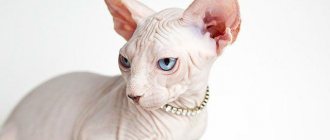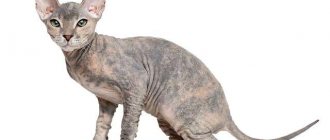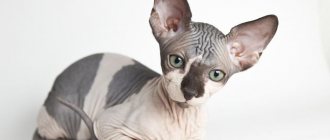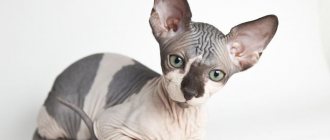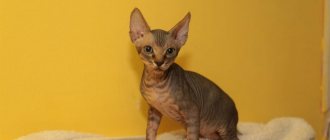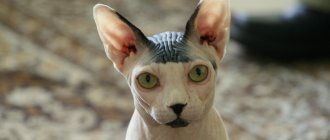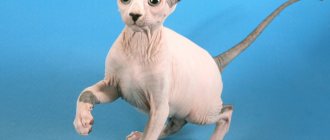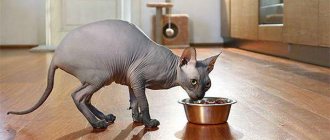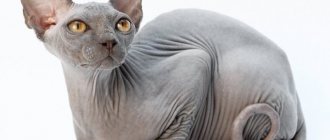The Sphynx is a hairless cat that evokes double feelings. Many are crazy about her unusual appearance, while others are repulsed by her alien features. In fact, a hairless cat (Sphynx cat) is a gentle, friendly and sociable creature. But before you decide to get such a kitten, you need to learn everything about sphinxes - what to feed, how to raise and properly care for them.
Sphynx cat: a brief history of the breed
Hairless cats are the result of a natural mutation. In ancient times they were popular and lived in the court of the Egyptian pharaohs. However, then their trace was lost. History is silent about what happened to those hairless representatives of the cat world.
According to some reports, until the 20s of the 20th century, there was a population of hairless cats in South America. These animals had an unusual appearance - a bald body, which was partially overgrown with hair only in the cold season, and large, expressive eyes of an amber hue. The South American breed of hairless cats has completely disappeared from the face of the earth, so its genetic characteristics cannot be studied.
In 1966, a hairless kitten appeared in one of the provinces of Ontario, Canada. The owner of a black and white short-haired cat discovered in her litter a baby completely different from the rest. He was bald and wrinkled, so his owner gave him the name Pruni, which means “prune.” When the hairless kitten grew up, the woman crossed him with his mother. It was not possible to achieve complete consolidation of the signs - hairless cats were found in only a few litters.
A few years later, 2 hairless cats were born in Minnesota, USA. Then active breeding work began. Hairless cats were crossed with representatives of other breeds. However, the best results were achieved when breeders used Devon Rex.
For a long time, felinologists did not recognize sphinxes because they feared that the mutation could provoke the development of serious diseases. Only in 1986 did TICA give the go-ahead for the participation of hairless cats in exhibitions and championships. Later this was done by the CCA and CFA organizations. The breed was called the “Canadian Sphynx”.
Exterior of an Egyptian cat
Sphynx cats are medium-boned cats that reach a weight of 5-7 kilograms. Despite their slight build, they are quite strong and muscular. Cats have a broad chest, a prominent belly, long legs and a thin, whip-like tail. The main distinguishing feature of the Sphinx is its fur, or rather its absence. The fur on the Sphynx's skin is so thin and short that it cannot be seen or even felt when stroking the cat.
In rare cases, pubescence is noticeable on the ears, muzzle, tail, paws and in the groin area of the animal. Patterns and colors may vary between cats as their color depends on the degree of skin pigmentation. Cats do not always have whiskers and eyebrows. The skin is quite wrinkled, especially in the head, neck and shoulder girdle. Because of this, animals always retain their characteristic “sullen” appearance. Some even believe that Sphynx cats are the scariest cats, but there are thousands of people who consider their unusual appearance elegant and aristocratic.
Other special features include the following exterior characteristics:
- wedge-shaped head;
- wide set large ears;
- prominent cheekbones;
- expressive oval-shaped eyes.
Sphynx cat: interesting facts
For those interested in Sphynxes, here are a few facts about these cute cats:
- They have an excellent appetite, as their body quickly gives off heat.
- Hairless cats come in different colors and even patterns on their bodies in the form of spots or stripes.
- Although the Sphynx seems too hot, its body temperature is almost the same as that of representatives of other breeds, only 0.5 degrees higher.
- A hairless cat can easily learn to open door handles and perform other manipulations.
- The Canadian Sphynx is not suitable for allergy sufferers.
Canadian
This type of sphinx is over 60 years old.
Description of Canadian cats:
- dense skin covered with barely noticeable fluff;
- elongated head, straight nose;
- large and completely hairless ears;
- expressive eyes located at a slight angle;
- a strong body, with slight folds, and short front legs.
At the tip of the Sphynx's tail there is often a tuft of fur that remains throughout its life.
Breed description, standards, appearance
The main feature of the sphinx is its naked, strong body, covered with folds, large ears like locators, and huge eyes. It is very pleasant to stroke such a cat - its skin resembles soft suede.
Sphynx cat - dimensions and weight
According to the official description, the Canadian Sphynx is a medium-sized cat with well-developed muscles. The average height at the withers is 30-35 cm. The weight of an adult Sphynx cat is 4-6 kg. Females are lighter and more graceful, their weight does not exceed 4.5 kg.
Anatomical characteristics
There are strict requirements for the appearance of sphinxes. According to the approved standard, cats should look like this:
- The head is medium-sized and has a wedge shape with smooth outlines.
- High cheekbones, strong chin.
- The frontal part of the Sphinx's head is flat, the muzzle is short.
- The ears are rounded at the ends and have a wide base. The outer edges extend slightly beyond the line of the head.
- The cat's whisker pads are convex, and the whiskers are either absent, curled or broken.
- Large oval eyes are located at a considerable distance from each other. The cat's gaze is a little slanted.
- The neck is quite strong, of medium length, smoothly turning into a wide, rounded chest.
- Muscular, strong body of medium length with a full belly.
- The length of the limbs is proportional to the body. The front legs are slightly shorter than the hind legs.
- Paws are oval with thick toes.
- The tail is long, thin, gradually tapering to the tip.
- Canadian Sphynxes have thick skin, which gathers into numerous folds on the head and neck.
Color and coat type
The colors of sphinxes are varied. They are determined by skin pigmentation and are:
- Plain. This group includes: black, white, blue, cream, lilac, red (red) and chocolate. Blue (gray) is a lightened version of the black color. If a Sphynx has pink skin, it means it is white.
- Two-color. They combine any color with white. The pigmented part of the skin should contrast against a light background. A mandatory requirement for a bicolor cat is that one ear must be colored.
- Color point. Kittens are born pink, but after some time they develop a dark mask on their nose, ears, paws and tail.
- Tortoiseshell. This color of the sphinx combines 3 colors - white, black, red. It occurs in females and males, but tortoiseshell cats cannot reproduce.
- Less common types of colors are van, tabby, harlequin, tonkin.
Although sphinxes appear to be completely naked, in reality they are not. Cats have fine hairs no more than 2 mm long on their bodies. Short and sparse hair is present on the outside of the ears, on the underbelly, between the toes and on the tail.
Possible breed defects
The disadvantage of the Sphynx breed is the presence of hair on those parts of the body where it should not be, as well as the length of the hairs is more than 2 mm. Other exterior defects:
- thin bones, graceful forms;
- underdeveloped muscles;
- straight profile;
- long and too narrow muzzle;
- small ears.
Attention! The body type of the Canadian Sphynx should not be similar to Devon Rex, Cornish Rex or Oriental cats.
Features of cats without hair
According to legends, the Egyptian Sphynx cat escorted the souls of the inhabitants of Ancient Egypt to the afterlife. According to legends, among the Aztecs, unusual hairless cats with large ears evoked reverence and respect. Allegedly, Aztec cats lived at temples, and the Aztecs revered hairless cats with large ears as divine beings.
The owners of modern Sfin cats jokingly prefer to classify their pets as alien creatures. Some owners simply say that sphinxes are magical cats. By the way, it’s hard to disagree with this statement. Everyone has long known the healing abilities of cats: cats find a sore spot on their owner, diligently knead it, massage it, and then lie down on the source of pain to warm it with their natural warmth. So, among Sfin purrs, these abilities of home healers are doubled due to the contact of the hot skin of a hairless cat with human skin.
Cats without fur need to be fed more often than their furry relatives. To maintain the necessary thermal balance of the body, the Sfin cat requires more frequent feeding and much more food than a purring cat with fur.
Sphynx body temperature
As for small hairless kittens, the normal temperature for them is 38.5-39.5⁰C. Metabolism in babies is higher, metabolic processes occur faster than in adult animals, therefore the normal body temperature in kittens is higher than in mature individuals.
In adult hairless cats and hairless cats, the normal body temperature is 38-39⁰C.
Do sphinxes have mustaches?
Many sphinxes either have no whiskers at all, or they are broken off or curled. In some Sphynx cats the whiskers fall out and grow back. Moreover, the process of loss and regrowth of whiskers in Sfin cats is a very individual matter, not amenable to any predictions.
In the language of zoologists, cat whiskers are called vibrissae; for purrs, this simple-looking device works both as protection from external dangers and as a means of navigation.
Cats are nocturnal animals and love to hunt in the dark. To recreate a complete picture of the environment, the cat uses sensitive antennae, with which it is able to detect air currents and vibrations.
If a cat's whisker touches any object, the purr will immediately trigger a defensive reaction - the cat will reflexively close its eyes. What if the obstacle touched by the vibrissa turns out to be a sharp branch, wire or some other dangerous object? Nature took care of the soft-footed meowing hunters, providing them with an additional organ of touch in the form of sensitive vibrissae.
Any Sphynx cat, although a representative of the cat family, is not a night hunter. A hairless cat is unable to survive either in the wild or on the street: it is an exclusively decorative creature bred to be kept at home. Such a pampered, whimsical animal does not particularly need a hunting attribute in the form of sensitive long whiskers.
Sphinx tail
The tail of a healthy animal should be flexible and mobile, thick at the base, gradually tapering towards the tip. Sphinxes often curl their sensitive whip-like tail into a ring, which adds even more mystery and piquancy to their unusual appearance. At the tip of the tail, sphinxes are allowed a “lion tassel” - a small tuft of hair.
Unfortunately, this part of the body in hairless cats can be problematic and bring a lot of inconvenience to the pet and its owner.
- Problem one: Anomalies, deformations and other defects of the tail, both congenital and acquired. A Sphynx of any breed that has an underdeveloped, deformed or broken tail will not be allowed for breeding. But that’s not so bad – not all pets can be the stars of a show. The trouble with congenital tail deformation is that a “broken” tail may turn out to be the tip of the iceberg, under which many diseases are hidden that threaten the health and even the life of the animal.
- Problem two: Angular cystic acne, acne, comedones. Both young animals during puberty and mature animals actively involved in breeding are susceptible to these unpleasant skin diseases.
The first of these misfortunes disfigures the cat's tail; angular cystic acne results in persistent scars that are almost impossible to remove with any absorbable ointments.
On the affected areas of the skin, cystic cavities filled with pus are formed; the inflamed foci can merge with each other and open out through the fistula tracts. The disease lasts a long time; a shell of keratinized skin particles and exudate forms on the inflamed areas.
Acne and comedones are more often observed in hairless (rubber) cats. To prevent acne, hairless animals are bathed in a decoction of chamomile or string. Also, do not forget to regularly wipe your pet’s tail with a special degreaser.
Do Sphynxes have fur?
Yes, there are.
According to the breed standard, only the Canadian Sphynx does not have varieties with fur. The animal's skin should have only minimal invisible fluff. There is short pubescence on the muzzle.
But domestic cats - the Peterbald and the Don Sphynx - according to the breed standard, allow individuals with different types of hair. We will talk about them in detail in the next section.
Did you know that a hairless cat can give birth to a fluffy kitten? In some individuals it falls out over time, while others remain fluffy.
Types of Sphynxes with fur
These types apply only to St. Petersburg and Don sphinxes:
- Brush . The coat of the Brush species can be either hard or soft and silky to the touch. The length of the hair is 2-3 mm. The coat can be straight and wavy, or crimped and hard, reminiscent of an old brush that has served its purpose.
- Flock . The skin of a flock animal is covered with tiny short hairs, reminiscent to the touch of a peach skin. As a rule, flock cats walk “in clothes” made of peach fluffs until they are 1.5-2 years old, then they completely “undress”.
- Velor . If you touch a velor seal, you are left with the feeling of touching velor or thin, very high-quality suede. The length of the hair is 2-3 mm. The fibers of velor individuals are much more noticeable than the tiny flock, barely visible to the human eye.
Why are sphinxes bald?
Genetics played a major role in the development of hairless cat breeds. Sphynxes are cats without hair, bald, cute mutants with an unusual appearance caused by the hairlessness gene. This mutation gene has long been tested by felinologists for stability, however, a hybrid of a Sfin cat and an ordinary cat is not always born bald.
Types of Sphynx cats
The Sphynx breed is represented by three species. In addition to the Canadian one, there is also the Don variety, which was bred in Rostov-on-Don, and the Peterbald - the creation of breeders from St. Petersburg.
The Canadian Sphynx is smaller than the Don Sphynx. The standard for this breed was approved in 1992. The Peterbald was obtained by crossing the Don variety with Oriental cats about 20 years ago.
How much does a hairless cat cost - price in Russia
Only three breeds of hairless cats are officially recognized by feline dog associations:
- Canadian Sphynx. The price of a kitten, depending on the class and elite status of the parents, varies from 8 to 100 thousand rubles.
- Don Sphynx. The price of a kitten varies from 9,000 rubles to 30,000 rubles.
- Peterbald. The cost varies from 5 to 25 thousand rubles.
There are also unrecognized breeds of hairless cats, for example, the Ukrainian Levkoy or the Bambino. However, despite the “unrecognition”, you won’t be able to buy a hairless cat on the cheap. Bambino will cost an average of 20-50 thousand rubles, and Ukrainian Levkoy - 10-20 thousand rubles.
Character and temperament of the Canadian Sphynx
Sphynx cats have high intelligence and a good-natured disposition. One of the main features of their character is their strong attachment to their owner. The pet follows him everywhere and willingly takes part in all activities. As soon as the opportunity presents itself, the cat will immediately sit next to you.
The Sphynx cat loves to climb on the shoulders or chest of the owner, closer to his face, rub against his owner's nose and purr softly. This is how they show complete trust. Sphynxes also love to talk.
A hairless cat cannot be left alone for a long time; it constantly needs communication and affection. Representatives of this breed become strongly attached to the members of the family in which they are raised. A long separation from the owner will be a real test for the Sphinx. Those who are forced to frequently go on business trips are not recommended to have such a cat.
Sphynxes are completely devoid of aggression, so you don’t have to be afraid to leave them alone with small children. A pet will never offend a child, even if he accidentally hurts him. Sphynxes get along well with other animals - small dogs, rabbits and cats of other breeds. Their hunting instinct is poorly developed, so they can be kept together with parrots, canaries or domestic rats.
Sphinxes feel comfortable even in a crowd of strangers if their owner is nearby. This character trait allows them to relax and show themselves in all their glory at the exhibition.
These are very smart cats. They easily remember commands, get accustomed to the tray and scratching post, and pick up the intonation of the owner. It may seem that the sphinx understands everything perfectly. You should not be rude when communicating with him, as he is extremely gentle and vulnerable. An offended cat will not take revenge, but someone who mistreats her may lose her trust forever.
Character
Although the breed has a repulsive appearance, the character of sphinxes is very friendly by nature and absolutely not aggressive; they are extremely rarely evil.
Cats love to play with toys, so owners will need to frequently clean up scattered objects after their pets.
The behavior of the sphinx is ideal; the pet does not have the habit of causing mischief at home. These animals love human attention. I especially like it when people talk to the cat.
Separation from household members is very difficult for these creatures; it is typical for the nature of this breed to fall into depression due to lack of communication. After something bad happens in the house, cats become lethargic.
They are by nature very vulnerable. Therefore, the owner should choose company for his pet during a long departure. Sphynxes get along well with other animals. By the way, the bald cat is not afraid of dogs at all.
These animals easily get along with children and participate in children's games without resistance. They do not shy away from guests and often demonstrate to guests their skills in eating food using their front paws. And this is not all the talents of these intelligent animals.
These cats can be trained and then they can bring objects in their teeth to their owner, open doors, etc. The cat quickly learns the ability to go to the litter box; you just need to show him where he is once.
The owners must raise the sphinx without shouting or assault - he will not understand the reason for such treatment. It is better to give your speech a strict emotional tone, which the cat catches best.
But the breed has no hunting instinct. This is due to its decorative nature. Representatives of the breed do not have whiskers, so they will not be able to survive on the street.
How to choose the right kitten
When choosing a purebred kitten, there is no need to try to save money. It is better to buy a four-legged friend from a nursery with a good reputation. The breeder is responsible for each animal he sells, so he will not cheat. Kittens are sold with all documents - veterinary vaccination certificates, pedigree, passport.
Before buying a Sphynx, it is advisable to get to know his parents better, because later the baby will look like them. For those who do not intend to continue breeding hairless cats, a pet-class pet is suitable. This is a healthy cat that has minor conformation defects and therefore cannot participate in breeding work. Such sphinxes are cheaper and are bred solely for maintenance.
Kitten care
There are 3-5 kittens in a cat's litter. They are born blind. Babies' eyes open around the 3-4th day. In the first weeks after lambing, the mother takes care of the babies. She feeds, washes and warms the cubs with her body.
A month later, the sphinxes are given their first complementary foods. You can give low-fat cottage cheese or boiled lean chopped meat. Until the age of three months, cats are fed 6 times a day, then they are transferred to four meals a day. Adults eat in the morning and evening.
Small Sphynx cats require special care. It is important to keep your skin clean, as it quickly becomes oily. Once a week, the cat should be washed with warm water without soap, and wiped daily with wet wipes. The eyes and ears of naked cats are carefully cleaned with cotton pads soaked in a special product.
Maintenance and feeding
Egyptian cats are omnivores, and they also love to overeat, which can cause obesity.
You are required to follow feeding standards and avoid overeating. The cat's diet includes meat, buckwheat and rice cereals, a small amount of fish, and chicken eggs. Accustom your pet to fruits and vegetables from childhood, otherwise it will not be easy later. You can include cottage cheese in the menu. Fatty, smoked foods and sweets are strictly prohibited. Potatoes are contraindicated for hairless cats. Only premium grade ready-made food is accepted.
Sphynx cats have good immunity and recover quickly. They have no congenital diseases. Lactating cats can produce too much milk, which can lead to mastitis. Like any cat, Sphynx cats live up to 15 years, but how long your cat will live depends only on you. If you want to prolong the life of your pet, then learn how to properly care for it, provide the necessary nutrition and do not forget about vaccination.
At what age should a cat be neutered? The optimal age for spaying or neutering a pet is 10 months. If the animal is castrated later, it will retain sexual behavior.
Sphynx cat - feeding
Hairless cats have faster metabolic processes than other breeds. They need more calories to maintain their body temperature.
Complete diet
When feeding dry formulas, preference is given to super-premium or holistic food from the following brands:
- Hills;
- Royal Canin;
- Acana;
- Pro Plan.
Some cat owners choose natural food for their pets. In this case, the Sphinx’s diet includes:
- lean meats - rabbit, veal, turkey, chicken;
- sea fish;
- cereals cooked in water without salt - buckwheat, rice, oatmeal;
- fermented milk products – low-fat cottage cheese, yogurt, sour cream;
- vegetables that have undergone heat treatment - carrots, broccoli, spinach;
- quail or chicken eggs (no more than 2 times a week).
Sphynx cats should not be fed processed foods, sausages, snacks, smoked meats, sweets, pork, bones and potatoes.
Sphynx cat - feeding frequency
Adult cats are fed 2 times a day - morning and evening. During the daytime, you can treat the sphinx with a small piece of treat. Small kittens should eat more often:
- from 1 to 3 months – 6 times a day;
- from 3 to 6 months – 4 times a day;
- from 6 to 9 months – 3 times.
Vitamins and minerals
There is no need to additionally introduce mineral and vitamin supplements into the Sphynx's diet if he eats high-quality industrial food.
Feeding is needed for cats that eat natural food. Complex preparations with vitamins must be given in courses 2 times a year. In order not to harm the health of the sphinx, you first need to show it to the veterinarian.
Nutrition
It is very important to discuss your unusual pet's diet with your veterinarian. It can be based on Royal Canin for cats, formulated taking into account the characteristics of this breed. You can choose another complete composition of good quality.
If the owner prefers to feed his pet natural food, then it should contain a lot of protein (offal, meat) with the addition of cereals and dairy products. In addition, caring for a Sphynx involves the following procedures:
- nail trimming;
- rubbing the eyes;
- ear cleaning;
- bathing.
Education and physical activity
When raising a Sphinx, you need to be persistent and patient. When training a cat, you should not yell at it or use force on it. It is better to use the incentive method. Every time your cat does what is expected of her, you should give her a treat.
Using this approach, the Sphinx can be taught:
- bring the ball on command;
- to open the door;
- and even flush the toilet.
Tips for choosing a kitten
You should not purchase a kitten through private sellers. Photos of hairless cats posted on a free message board on the Internet may turn out to be fictitious. Outbred shaved cats are often passed off as Sphynxes. It is almost impossible to spot deception without the help of an experienced breeder or felinologist.
You can purchase a healthy and purebred animal from a large nursery or from a professional breeder who is a member of a club or association of cat lovers. In both cases, sellers are required to present a license confirming the legality of their activities. Along with the kitten, the buyer must receive a purchase and sale agreement, a veterinary passport and breeding documents. Breeding documents include:
- Metrics. Contains basic information about the kitten and its parents. If the animal belongs to the pet class, then its defects are reflected in the metric: excessive amount of fur, insufficient number of folds, and others.
- Pedigree. Unlike the metric, it is issued at the buyer’s request and increases the final cost of the kitten. If you do not plan to breed or participate in an exhibition, then you can refuse the pedigree. In this case, the price of the pet will be lower.
When choosing among Sphynx kittens, consider your purchase goals. If you buy a pet for the soul, then it is enough to choose a healthy and active animal. Buyers with higher demands are advised to seek advice from a felinologist, breeder or veterinarian.
Health and susceptibility to disease
The average lifespan of a Sphynx is 13-14 years. With good care, cats rarely get sick, but they still have a predisposition to certain diseases:
- Turning of the eyelids. This is a congenital pathology that surgery can correct.
- Vasculitis. An inflammatory process affecting the walls of blood vessels. The problem is manifested by the appearance of bluish or reddish dots on the skin.
- Kitten sleep syndrome. When homozygous sphinxes mate, non-viable kittens are born. Due to serious pathologies of internal organs, they die soon after birth.
- Acne. Acne in Sphynx cats occurs due to excess sebum production.
Features of mating and pregnancy
The first estrus in females begins at 6 months, but mating with a cat during this period is not possible, since the hormonal background has not yet formed. The male becomes fully sexually mature by 8 months. They can be brought together only after the girl’s third heat, that is, at about 1.5 years. In this case, the probability of obtaining healthy offspring is maximum. Before estrus, both animals must receive all the necessary vaccinations and carry out grooming procedures with their claws, otherwise they may damage each other during the mating process.
It is prohibited to cross different types of sphinxes, for example, a Canadian with a St. Petersburger. In this case, the probability of getting sick and non-viable kittens is almost 100%. The first signs of pregnancy in a cat are noticeable in the third week. The nipples become deep pink, and the belly begins to increase in volume. Pregnancy lasts 65 days. In about a week, you need to prepare a place for her where the cat will give birth. This should be a quiet, secluded place, with warm and soft bedding. There are approximately 4-6 kittens in the litter.
Sterilization and castration
If the Sphynx has defects that do not allow it to take part in future breeding, the cat must be castrated or sterilized. The procedure is carried out at the age of 7 to 12 months. Veterinarians do not recommend performing surgery too early, but it is advisable to do it before the moment when the cat wants to go for a walk.
Castration is performed under anesthesia, so it is absolutely painless. The operation lasts about 20 minutes. After its completion, the sphinx is taken home.
Characteristics and standard
The standards are different for each variety, but any nuance is important for participation in exhibitions. Canadians have a slender, muscular body, a rounded chest, powerful shoulders, a wedge-shaped head, and a long neck. The cheekbones are prominent, the forehead is flat, the chin is pronounced. The eyes are oval, large, amber in color. The ears are huge, with rounded tips and set wide apart.
The limbs have long fingers. The tail is straight and mobile. The Don Sphynx should also have a muscular body, a wedge-shaped head and pronounced cheekbones. The hind legs of the Don Sphynx are longer than the front legs. The St. Petersburg Sphynx should have a long nose, a slender figure, thin and long limbs, and large ears.
Sphynx cat: pros and cons
A hairless cat has many advantages, but there are also some disadvantages:
| pros | Minuses |
| Lack of fur | Need for careful care |
| Friendly disposition | Strong dependence on a person |
| High intelligence | Need for clothing (additional expenses) |
| Indiscriminate eating | High feed consumption |
| Good health | |
| A cat's ability to get along with other animals | |
| Underdeveloped hunting instinct | |
| Various color palette |
Owners of Sphynx cats speak of them with love and tenderness. They are often compared to dogs, because hairless pets follow their owner's heels and constantly climb into their arms.
A gentle and friendly creature with a non-standard appearance is ideal for both a lonely elderly person and families with small children.
Health
Hairless pets are especially susceptible to skin diseases and colds. For prevention, the following measures should be taken:
- Maintain the temperature in the room where the cat lives from 20 ⁰С to 25 ⁰С, avoid drafts.
- Limit your pet's time in direct sunlight or near heaters to avoid burns or heat shock.
- In winter, dress the cat in special clothes to prevent hypothermia.
- Monitor the condition of the cat's lacrimal glands and ear canals, not forgetting about regular hygiene procedures.
- Monitor your pet's diet to rule out gastrointestinal diseases and excess weight problems.
- Vaccinate the animal in a timely manner (primary vaccination at 2 months, after reaching the age of 1 year - annually).
If the requirements are met correctly, hairless cats live a full life, the normal duration of which is 15-20 years.
The choice of a hairless cat as a pet is often due to the presence of allergic diseases. It should be understood that allergies are most often caused not by the pet’s fur itself, but by the D1 protein produced by the cat’s glands. Before purchasing an animal, you should conduct the necessary tests to identify the source of the allergy. If the allergen is protein D1, the patient is advised to limit contact with any cats.
